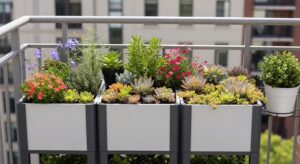Rooftop gardens are changing urban skylines, bringing nature back to our concrete jungles. Rooftop gardening offers a creative and eco-friendly way to use underutilized space to relax, grow vegetables, or benefit the environment. This guide will walk you through each step to create a thriving rooftop green space.
1. Understand the Purpose of Your Rooftop Garden
Before you start to design or plant, decide on the purpose of your urban rooftop garden. Do you want to grow vegetables and herbs? Are you looking for a quiet place to unwind? Or do you aim to enhance aesthetics or biodiversity?
Why It Matters:
- Guides your plant and layout choices.
- Shape your tool picks and upkeep methods.
- Boosts long-term success and happiness.
Expert Insight: City garden pros suggest matching your garden’s goal to your lifestyle and free time to make sure you can keep it up well.
2. Examine the structure’s strength and weight limits
Some roofs can’t handle extra weight. Getting a structural engineer to check your roof’s weight-bearing ability is key.
What to Check:
- Weight-bearing ability per square foot.
- How water drains.
- State of the waterproof layer.
- How to get in for upkeep.
Expert Advice: Talk to your building management or local officials about codes and permits for rooftop installations.
3. Make a Plan for Waterproofing and Drainage
Water can build up on urban rooftop gardens and damage your building. You need a good system to drain water.
Steps to Take:
- Install drainage mats or create a sloped surface.
- Add a layer of gravel on top of soil beds.
- Check that containers have enough drainage holes.
Reliable Tips: To avoid long-term damage to the building, hire professionals to install a waterproof membrane, root barrier, and protective mat layers.
4. Choose the Right Growing Medium
The soil for rooftop gardens needs to be rich in nutrients, light, and have good drainage. Don’t use regular soil from your garden.
Recommended Mix: Light compost, Vermiculite or perlite, Coco coir to hold moisture
Pro Tip: For rooftop gardens on tall buildings, experts often suggest using soilless mixtures. These weigh less and allow water to drain better.
5. Pick Plants That Can Handle Rooftop Conditions
Rooftop gardens face unique challenges like wind, bright sun, and limited water. You need to choose plants that can deal with these conditions.
Best Plant Types:
- Succulents and Cacti: These plants can handle dry conditions and need little care.
- Herbs: Basil, rosemary mint.
- Vegetables: Tomatoes, peppers, lettuce.
- Ornamentals: marigolds, lavender, and decorative grasses
Analyst Recommendation: Put plants with similar water and sun needs together to make care easier.
6. Create the Layout
How you arrange things affects how well the garden works, looks, and how easy it is to take care of. Draw a plan or use apps made for garden design.
You Must Include:
- Paths and areas you can reach.
- Places to sit.
- Gardens that grow up walls or on supports.
- Spots for containers that don’t take up much room.
Design Tip: Use light modular containers to have flexibility. Add windbreaks such as bamboo fences or trellises with climbing plants.
7. Set Up Irrigation and Watering Systems
Watering a rooftop garden by hand can take a lot of time. Automating this process boosts productivity.
Options:
- Drip irrigation systems.
- Self-watering planters.
- Rainwater collection with storage tanks.
Sustainability Advice: Smart irrigation controllers cut down on water waste and keep moisture at the right levels.
8. Put Safety Measures in Place
For rooftop gardening on tall buildings, safety comes first.
Safety Measures:
- Put up sturdy railings or fences.
- Install slip-resistant floors.
- Keep tool storage clear of emergency exits.
Expert Caution: Secure all items in your garden to withstand strong winds.
9. Add Furniture and Aesthetic Elements
You’ll want to spend time on your rooftop because it’s beautiful and comfortable.
Ideas:
- Weather-resistant furniture
- Lights powered by the sun
- Pretty plant containers
- Feeders for birds or water features
Lifestyle Insight: Even small decorative items like wind chimes or lanterns can have a big impact on the atmosphere.
10. Grow and Maintain Your Garden
To keep your rooftop garden thriving and healthy, you need to maintain it.
Routine Tasks:
- Prune and weed.
- Mulch and fertilize
- Rotate plants by season.
- Control pests.
Long-Term Tip: Keep an eye on how your plants perform and be ready to change your layout and plant choices as your needs change.
Common Errors in Rooftop Gardening to Avoid
- Not Checking the Structure: This can damage your building over time.
- Bad Drainage: Results in plant root rot and structural damage.
- Plant overcrowding: Makes upkeep harder and blocks air circulation.
- Inconsistent watering: Causes plant disease or stress.
- Ignoring Local Climate: Choose plants that do well in your region.
Environmental and Health Benefits of Rooftop Gardens
- Better Air Quality: Plants clean out pollutants.\
- Temperature Control: Cuts down the urban heat island effect.
- Food security: quick access to top-notch produce.
- Less Stress: Green areas boost mental health.
- Helps birds, bees, and good bugs through a more diverse life.
Conclusion:
Turning your rooftop into a green space goes beyond simple gardening; it enhances your way of life. With thoughtful preparation, proper equipment, and consistent maintenance, your rooftop can transform into a peaceful, eco-friendly retreat. The Rooftop Gardens projects across the world prove that even tiny areas can trigger significant environmental shifts.
Do you want to give your rooftop a makeover? Share your ideas and stories in the comments below!








